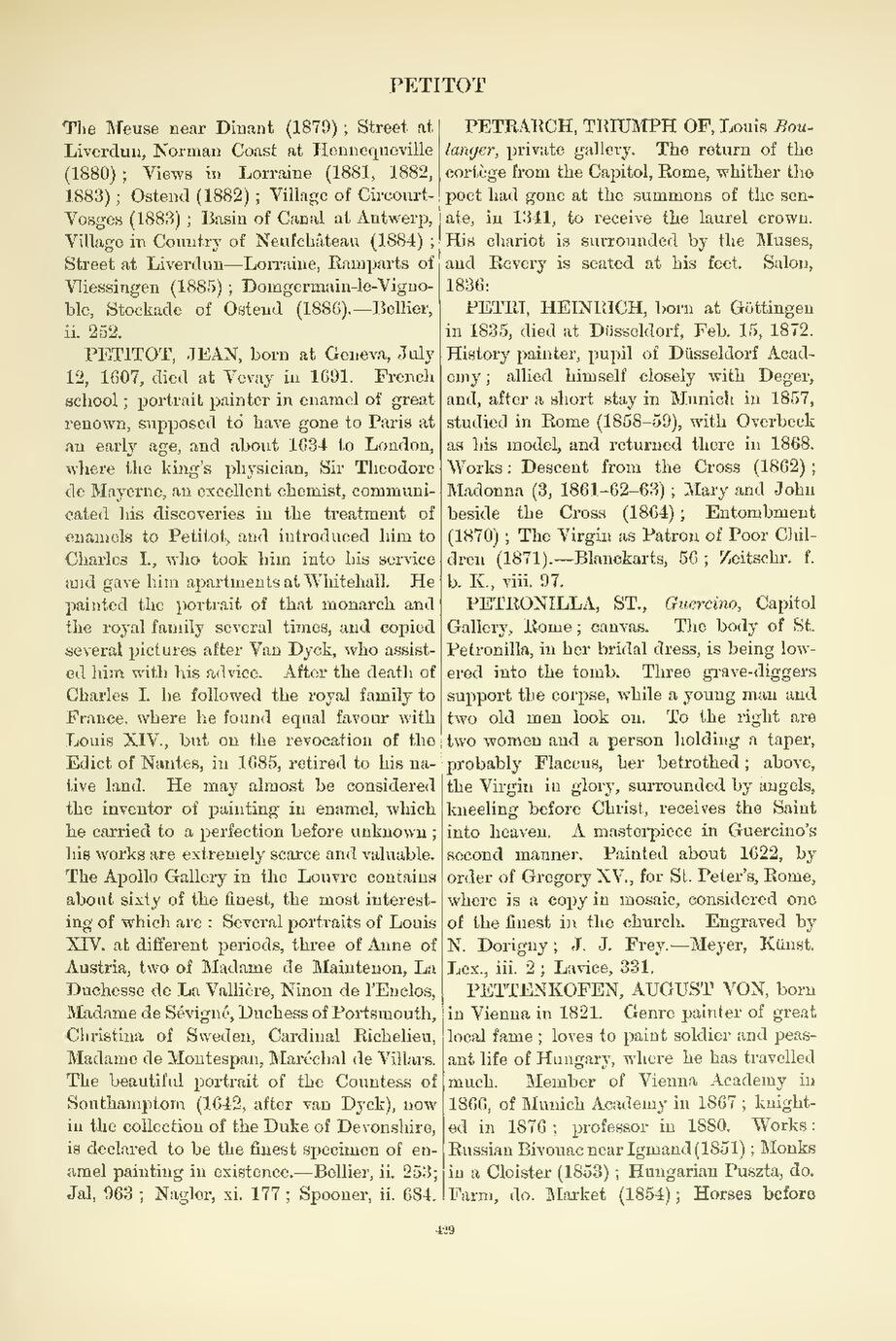The Meuse near Dinant (1879); Street at Liverdun, Norman Coast at Hennequeville (1880); Views in Lorraine (1881, 1882, 1883); Ostend (1882); Village of Circourt-Vosges (1883); Basin of Canal at Antwerp, Village in Country of Neufchâteau (1884); Street at Liverdun—Lorraine, Ramparts of Vliessingen (1885); Domgermain-le-Vignoble, Stockade of Ostend (1886).—Bellier, ii. 252.
PETITOT, JEAN, born at Geneva, July
12, 1607, died at Vevay in 1691. French
school; portrait painter in enamel of great
renown, supposed to have gone to Paris at
an early age, and about 1634 to London,
where the king's physician, Sir Theodore
de Mayerne, an excellent chemist, communicated
his discoveries in the treatment of
enamels to Petitot, and introduced him to
Charles I., who took him into his service
and gave him apartments at Whitehall. He
painted the portrait of that monarch and
the royal family several times, and copied
several pictures after Van Dyck, who assisted
him with his advice. After the death of
Charles I. he followed the royal family to
France, where he found equal favour with
Louis XIV., but on the revocation of the
Edict of Nantes, in 1685, retired to his native
land. He may almost be considered
the inventor of painting in enamel, which
he carried to a perfection before unknown;
his works are extremely scarce and valuable.
The Apollo Gallery in the Louvre contains
about sixty of the finest, the most interesting
of which are: Several portraits of Louis
XIV. at different periods, three of Anne of
Austria, two of Madame de Maintenon, La
Duchesse de La Vallière, Ninon de l'Enclos,
Madame de Sévigné, Duchess of Portsmouth,
Christina of Sweden, Cardinal Richelieu,
Madame de Montespan, Maréchal de Villars.
The beautiful portrait of the Countess of
Southamptom (1642, after van Dyck), now
in the collection of the Duke of Devonshire,
is declared to be the finest specimen of enamel
painting in existence.—Bellier, ii. 253;
Jal, 963; Nagler, xi. 177; Spooner, ii. 684.
PETRARCH, TRIUMPH OF, Louis Boulanger,
private gallery. The return of the
cortège from the Capitol, Rome, whither the
poet had gone at the summons of the senate,
in 1341, to receive the laurel crown.
His chariot is surrounded by the Muses,
and Revery is seated at his feet. Salon,
1836:
PETRI, HEINRICH, born at Göttingen
in 1835, died at Düsseldorf, Feb. 15, 1872.
History painter, pupil of Düsseldorf Academy;
allied himself closely with Deger,
and, after a short stay in Munich in 1857,
studied in Rome (1858-59), with Overbeck
as his model, and returned there in 1868.
Works: Descent from the Cross (1862);
Madonna (3, 1861-62-63); Mary and John
beside the Cross (1864); Entombment
(1870); The Virgin as Patron of Poor Children
(1871).—Blanckarts, 56; Zeitschr. f.
b. K., viii. 97.
PETRONILLA, ST., Guercino, Capitol
Gallery, Rome; canvas. The body of St.
Petronilla, in her bridal dress, is being lowered
into the tomb. Three grave-diggers
support the corpse, while a young man and
two old men look on. To the right are
two women and a person holding a taper,
probably Flaccus, her betrothed; above,
the Virgin in glory, surrounded by angels,
kneeling before Christ, receives the Saint
into heaven. A masterpiece in Guercino's
second manner. Painted about 1622, by
order of Gregory XV., for St. Peter's, Rome,
where is a copy in mosaic, considered one
of the finest in the church. Engraved by
N. Dorigny; J. J. Frey.—Meyer, Künst.
Lex., iii. 2; Lavice, 331.
PETTENKOFEN, AUGUST VON, born
in Vienna in 1821. Genre painter of great
local fame; loves to paint soldier and peasant
life of Hungary, where he has travelled
much. Member of Vienna Academy in
1866, of Munich Academy in 1867; knighted
in 1876; professor in 1880. Works:
Russian Bivouac near Igmand (1851); Monks
in a Cloister (1853); Hungarian Puszta, do.
Farm, do. Market (1854); Horses before
